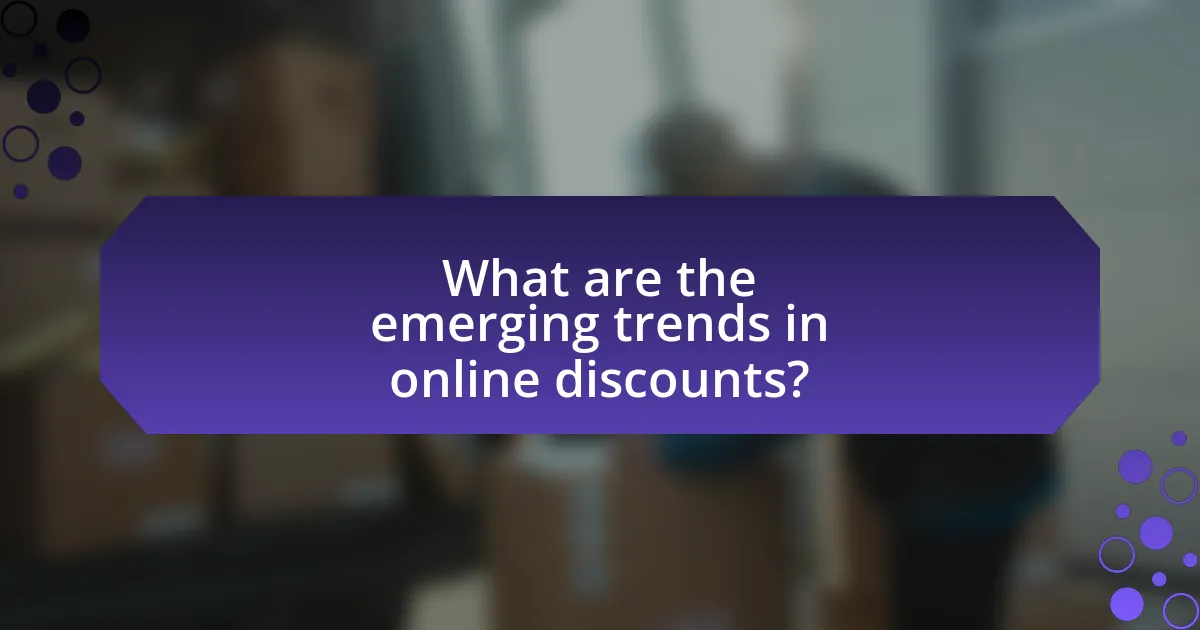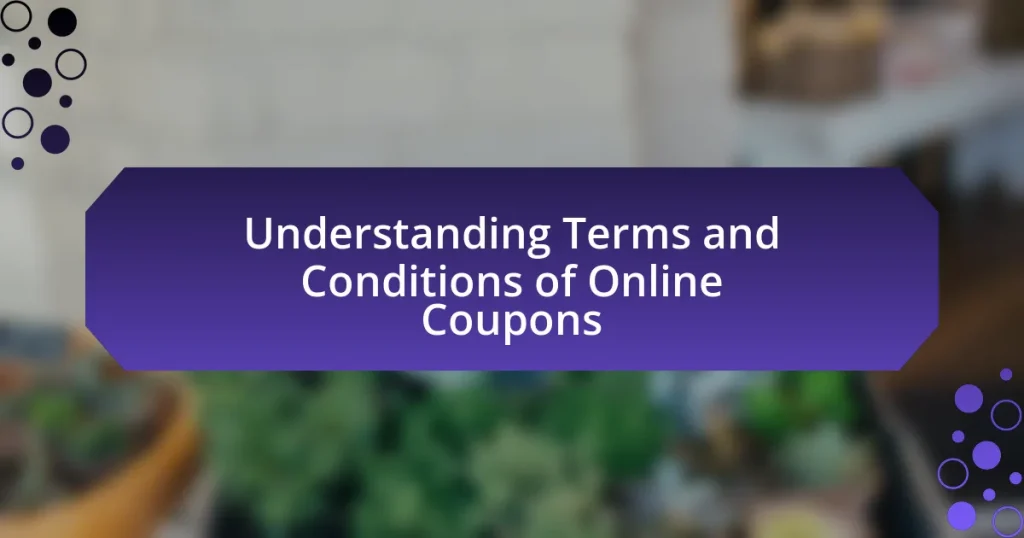The article focuses on the future of online discounts, highlighting emerging trends such as personalized pricing, subscription-based discounts, and the application of artificial intelligence for dynamic pricing. It examines changing consumer behaviors, emphasizing the preference for personalized and time-sensitive offers, and discusses factors influencing consumer decisions, including perceived value and urgency. Additionally, the article explores the impact of social media and influencers on discount perceptions, the role of technological advancements, and the importance of personalization in discount strategies. It also addresses the risks associated with excessive discounting and provides best practices for businesses to implement effective discount campaigns while maintaining brand integrity.

What are the emerging trends in online discounts?
Emerging trends in online discounts include personalized pricing, subscription-based discounts, and the use of artificial intelligence for dynamic pricing. Personalized pricing leverages consumer data to tailor discounts to individual preferences, enhancing customer engagement and loyalty. Subscription-based discounts, where consumers pay a recurring fee for exclusive deals, have gained popularity, with companies like Amazon offering Prime memberships that provide significant savings. Additionally, artificial intelligence enables retailers to adjust prices in real-time based on demand, competition, and consumer behavior, optimizing sales and inventory management. These trends reflect a shift towards more targeted and efficient discount strategies in the online marketplace.
How are consumer behaviors changing regarding online discounts?
Consumer behaviors regarding online discounts are increasingly characterized by a preference for personalized and time-sensitive offers. Research indicates that 80% of consumers are more likely to make a purchase when they receive personalized discounts tailored to their shopping habits, as reported by a study from McKinsey & Company. Additionally, the urgency created by limited-time offers has shown to drive a 30% increase in conversion rates, according to data from HubSpot. This shift reflects a growing expectation for brands to deliver relevant and immediate value, influencing how consumers engage with online shopping platforms.
What factors influence consumer decisions on discounts?
Consumer decisions on discounts are influenced by perceived value, urgency, and social proof. Perceived value refers to how consumers assess the worth of a discount in relation to the product’s original price; higher perceived savings can lead to increased purchase likelihood. Urgency, often created through limited-time offers, prompts quicker decision-making, as consumers fear missing out on a good deal. Social proof, such as reviews or testimonials, reinforces trust in the discount’s legitimacy and the product’s quality, further motivating purchases. Research indicates that 70% of consumers are more likely to buy a product when they see it discounted, highlighting the significant impact of these factors on consumer behavior.
How do social media and influencers impact discount perceptions?
Social media and influencers significantly shape discount perceptions by creating a sense of urgency and exclusivity around promotions. Influencers often showcase discounts in a way that enhances their appeal, leveraging their credibility to validate the value of the offer. For instance, a study by the Digital Marketing Institute found that 49% of consumers rely on influencer recommendations for their purchasing decisions, indicating that influencers can effectively alter perceptions of discounts. Additionally, social media platforms facilitate the rapid dissemination of promotional content, allowing discounts to reach a wider audience quickly, which can amplify their perceived value.
What technological advancements are shaping online discounts?
Technological advancements such as artificial intelligence, machine learning, and big data analytics are significantly shaping online discounts. These technologies enable retailers to analyze consumer behavior and preferences, allowing for personalized discount offerings that increase conversion rates. For instance, AI algorithms can predict which products a customer is likely to purchase based on their browsing history, leading to targeted promotions. Additionally, big data analytics helps businesses optimize pricing strategies by analyzing market trends and competitor pricing, ensuring that discounts remain competitive and appealing. According to a report by McKinsey, companies that leverage advanced analytics can increase their marketing ROI by 15-20%, demonstrating the effectiveness of these technological advancements in enhancing online discount strategies.
How is artificial intelligence being utilized in discount strategies?
Artificial intelligence is utilized in discount strategies by analyzing consumer behavior and preferences to optimize pricing and promotional offers. AI algorithms process vast amounts of data, including purchase history and browsing patterns, to identify the most effective discount rates that maximize sales while maintaining profit margins. For instance, retailers like Amazon employ machine learning models to dynamically adjust prices based on real-time market conditions and competitor pricing, resulting in increased conversion rates and customer satisfaction. This data-driven approach allows businesses to tailor discounts to specific customer segments, enhancing the effectiveness of their marketing efforts.
What role do mobile apps play in the future of online discounts?
Mobile apps will significantly enhance the future of online discounts by providing personalized shopping experiences and real-time offers. These applications leverage user data to tailor discounts based on individual preferences and shopping behaviors, increasing engagement and conversion rates. For instance, a study by Statista indicates that mobile commerce is projected to account for 54% of total e-commerce sales by 2025, highlighting the growing importance of mobile platforms in retail. Additionally, mobile apps facilitate instant notifications about discounts, allowing users to act quickly, which can lead to increased sales for retailers.
Why is personalization important in online discount strategies?
Personalization is important in online discount strategies because it enhances customer engagement and increases conversion rates. Tailoring discounts to individual preferences and behaviors leads to a more relevant shopping experience, which studies show can boost sales by up to 20%. For instance, a report by McKinsey & Company indicates that personalized marketing can lead to a 10-30% increase in revenue. By analyzing customer data, businesses can create targeted offers that resonate with specific segments, ultimately driving customer loyalty and repeat purchases.
How can businesses effectively implement personalized discounts?
Businesses can effectively implement personalized discounts by leveraging customer data to tailor offers based on individual purchasing behavior and preferences. By utilizing advanced analytics and machine learning algorithms, companies can segment their customer base and identify patterns that inform discount strategies. For instance, a study by McKinsey & Company found that personalized marketing can lead to a 10-30% increase in sales, demonstrating the effectiveness of targeted discounts. Additionally, integrating customer feedback and engagement metrics allows businesses to refine their discount offerings continuously, ensuring they resonate with the intended audience.
What are the potential challenges of personalization in discounts?
The potential challenges of personalization in discounts include data privacy concerns, algorithmic bias, and customer segmentation difficulties. Data privacy concerns arise as companies collect and analyze personal information to tailor discounts, leading to potential breaches of consumer trust and regulatory compliance issues, such as those outlined in the General Data Protection Regulation (GDPR). Algorithmic bias can occur when the data used to personalize discounts reflects existing inequalities, resulting in unfair treatment of certain customer groups. Additionally, accurately segmenting customers for personalized discounts can be complex, as it requires comprehensive data analysis and understanding of consumer behavior, which may not always be feasible or accurate.

How do online discounts affect business strategies?
Online discounts significantly influence business strategies by driving customer acquisition and retention. Businesses often implement online discounts to attract new customers, as studies show that 70% of consumers are more likely to purchase from a brand offering discounts. Additionally, these discounts can enhance customer loyalty; for instance, 60% of consumers report that they are more likely to return to a retailer that provides regular promotions. Consequently, companies adjust their pricing strategies, marketing campaigns, and inventory management to incorporate online discounts, ensuring they remain competitive in a digital marketplace.
What are the benefits of offering online discounts for businesses?
Offering online discounts benefits businesses by increasing customer acquisition and boosting sales. These discounts attract new customers who may be hesitant to purchase at full price, leading to higher traffic and conversion rates. For instance, a study by the National Retail Federation found that 66% of consumers are more likely to make a purchase if they receive a discount. Additionally, online discounts can enhance customer loyalty, as satisfied customers are more likely to return for future purchases. This loyalty is supported by research from Bain & Company, which indicates that increasing customer retention by just 5% can lead to a profit increase of 25% to 95%. Overall, online discounts serve as a strategic tool for businesses to enhance their market presence and drive revenue growth.
How do discounts drive customer acquisition and retention?
Discounts drive customer acquisition and retention by creating immediate incentives for new customers to make a purchase and encouraging repeat business from existing customers. Research indicates that 60% of consumers are more likely to try a new brand when offered a discount, demonstrating how price reductions can attract new clientele. Additionally, discounts foster loyalty; studies show that 70% of consumers are more likely to return to a brand that offers them regular promotions. This dual effect of attracting new customers while retaining existing ones underscores the strategic importance of discounts in driving overall business growth.
What impact do discounts have on brand loyalty?
Discounts can significantly enhance brand loyalty by incentivizing repeat purchases and fostering a sense of value among consumers. When brands offer discounts, they create an immediate financial benefit that encourages customers to return, as evidenced by a study from the Journal of Marketing Research, which found that 60% of consumers are more likely to remain loyal to a brand that provides regular discounts. This financial incentive not only attracts new customers but also reinforces existing relationships, as customers perceive the brand as caring about their financial well-being. Additionally, discounts can lead to increased customer satisfaction, which is a critical factor in building long-term loyalty.
What are the risks associated with online discounting?
The risks associated with online discounting include potential revenue loss, brand devaluation, and increased competition. Revenue loss occurs when discounts significantly reduce profit margins, leading to unsustainable pricing strategies. Brand devaluation can happen if consumers perceive discounted products as lower quality, damaging long-term brand equity. Increased competition arises as more businesses adopt aggressive discounting tactics, making it challenging to maintain market share. According to a study by the Harvard Business Review, companies that frequently discount can see a 20-30% decrease in perceived value among consumers, highlighting the financial and reputational risks involved.
How can excessive discounting harm a brand’s image?
Excessive discounting can harm a brand’s image by creating a perception of lower quality and diminishing brand value. When a brand frequently offers significant discounts, consumers may begin to associate the brand with lower prices rather than premium quality, leading to a decline in perceived brand equity. Research indicates that brands that rely heavily on discounts can experience a 20% to 30% drop in perceived value over time, as consumers may question the authenticity and quality of the products. This perception can result in long-term damage to customer loyalty and brand reputation, as customers may only purchase during sales rather than valuing the brand for its inherent qualities.
What strategies can mitigate the risks of discounting?
Implementing tiered discount structures can mitigate the risks of discounting by maintaining perceived value while encouraging higher spending. This strategy allows businesses to offer discounts that increase with the purchase amount, which can drive larger transactions without devaluing the brand. For instance, a study by the Journal of Marketing Research found that tiered discounts can lead to a 20% increase in average order value compared to flat discounts. Additionally, limiting the duration of discounts creates urgency, prompting quicker purchasing decisions while preserving brand integrity. Research from the Harvard Business Review indicates that time-limited offers can enhance consumer perception of value, reducing the risk of habitual discount-seeking behavior.
How do seasonal trends influence online discount strategies?
Seasonal trends significantly influence online discount strategies by dictating the timing and nature of promotions. Retailers often align discounts with seasonal events, such as holidays or back-to-school periods, to maximize consumer engagement and sales. For instance, a study by the National Retail Federation found that 75% of consumers plan to take advantage of holiday sales, prompting retailers to offer targeted discounts during these peak shopping times. Additionally, data from Adobe Analytics indicates that online sales during Black Friday and Cyber Monday have consistently surged, leading retailers to implement aggressive discount strategies to capture consumer interest. Thus, understanding seasonal trends allows businesses to optimize their discount offerings, ensuring they resonate with consumer behavior and drive sales effectively.
What are the key seasons for online discounts?
The key seasons for online discounts include Black Friday, Cyber Monday, and the back-to-school period. Black Friday, occurring the day after Thanksgiving, is known for significant sales across various online retailers, with discounts often exceeding 30%. Cyber Monday, following Black Friday, focuses on online shopping and has seen sales increase annually, with a reported $10.8 billion in sales in 2020 alone. The back-to-school season, typically from late July to early September, also features substantial discounts on school supplies and apparel, with retailers offering promotions to attract budget-conscious consumers. These seasons are characterized by heightened consumer spending and strategic marketing efforts by retailers to maximize sales.
How can businesses prepare for seasonal discounting effectively?
Businesses can prepare for seasonal discounting effectively by analyzing historical sales data to identify peak shopping periods and customer preferences. This data-driven approach allows businesses to tailor their discount strategies to maximize sales during high-demand seasons. For instance, a study by the National Retail Federation found that 75% of consumers plan their shopping around sales events, indicating the importance of aligning discounts with consumer behavior. Additionally, businesses should ensure their inventory levels are sufficient to meet anticipated demand, as a well-stocked inventory can prevent lost sales opportunities during peak discount periods.

What are the best practices for implementing online discounts?
The best practices for implementing online discounts include clearly defining discount terms, utilizing targeted marketing strategies, and ensuring a seamless user experience. Clearly defined terms, such as expiration dates and usage limits, help prevent customer confusion and dissatisfaction. Targeted marketing strategies, such as segmenting audiences based on purchasing behavior, can increase conversion rates; for instance, studies show that personalized offers can lead to a 20% increase in sales. Additionally, a seamless user experience, including easy application of discounts at checkout, enhances customer satisfaction and encourages repeat purchases.
How can businesses create effective discount campaigns?
Businesses can create effective discount campaigns by clearly defining their target audience and tailoring offers to meet their specific needs. Research indicates that personalized discounts can increase customer engagement by up to 20%, as consumers are more likely to respond to promotions that resonate with their preferences. Additionally, utilizing data analytics to track customer behavior allows businesses to optimize discount strategies, ensuring that promotions are timely and relevant. Implementing a sense of urgency, such as limited-time offers, can further enhance effectiveness, as studies show that urgency can boost conversion rates by 30%.
What types of discounts resonate most with consumers?
Percentage-off discounts resonate most with consumers, as they provide a clear and immediate understanding of savings. Research indicates that 70% of consumers prefer percentage discounts over fixed amount discounts because they perceive them as more valuable, especially for higher-priced items. Additionally, buy-one-get-one-free offers are also highly effective, appealing to consumers’ desire for added value and perceived savings. According to a study by the National Retail Federation, 60% of shoppers are motivated by such promotions, demonstrating their strong impact on purchasing decisions.
How should businesses communicate discounts to their audience?
Businesses should communicate discounts to their audience through clear, targeted messaging across multiple channels. Effective communication involves using email marketing, social media platforms, and website banners to ensure maximum visibility. For instance, a study by the Direct Marketing Association found that email marketing has an average return on investment of $42 for every dollar spent, highlighting its effectiveness in reaching consumers with discount offers. Additionally, utilizing urgency in messaging, such as limited-time offers, can increase engagement and prompt quicker purchasing decisions.
What metrics should businesses track to measure discount effectiveness?
Businesses should track metrics such as conversion rate, average order value (AOV), customer acquisition cost (CAC), and customer retention rate to measure discount effectiveness. The conversion rate indicates the percentage of visitors who make a purchase after seeing a discount, providing insight into the discount’s impact on sales. Average order value reflects the average amount spent per transaction, which can show whether discounts encourage larger purchases. Customer acquisition cost helps assess the cost-effectiveness of attracting new customers through discounts, while customer retention rate measures how well discounts foster repeat business. These metrics collectively provide a comprehensive view of how discounts influence sales performance and customer behavior.
How can conversion rates be improved through discount strategies?
Conversion rates can be improved through discount strategies by creating a sense of urgency and perceived value among consumers. Implementing time-limited discounts, such as flash sales or seasonal promotions, encourages immediate purchasing decisions, as consumers fear missing out on a good deal. Research indicates that urgency can increase conversion rates by up to 332% when effectively communicated. Additionally, offering personalized discounts based on customer behavior and preferences enhances engagement, leading to higher conversion rates. For instance, a study by the Harvard Business Review found that personalized offers can increase sales by 20% or more, demonstrating the effectiveness of tailored discount strategies in driving conversions.
What role does customer feedback play in refining discount offers?
Customer feedback plays a crucial role in refining discount offers by providing insights into customer preferences and behaviors. This feedback allows businesses to tailor their discount strategies to better meet the needs and expectations of their target audience. For instance, data from surveys and reviews can reveal which products customers are most interested in, enabling companies to create targeted discounts that drive sales. Additionally, analyzing customer responses to previous discount campaigns helps identify what types of offers resonate most, leading to more effective promotions. Research indicates that companies utilizing customer feedback in their discount strategies can see an increase in customer satisfaction and loyalty, ultimately enhancing sales performance.
What are some common pitfalls to avoid in online discounting?
Common pitfalls to avoid in online discounting include failing to clearly communicate the terms of the discount, which can lead to customer confusion and dissatisfaction. Additionally, businesses often underestimate the impact of discounting on brand perception; excessive discounts can devalue a brand in the eyes of consumers. Another significant pitfall is not analyzing the effectiveness of discount campaigns, which can result in wasted resources and missed opportunities for optimization. According to a study by the Harvard Business Review, companies that do not track the performance of their discount strategies can lose up to 30% in potential revenue. Lastly, neglecting to consider the long-term effects of discounting on customer loyalty can lead to a reliance on discounts rather than fostering genuine customer relationships.
How can businesses ensure discounts do not devalue their products?
Businesses can ensure discounts do not devalue their products by implementing strategic pricing and maintaining perceived value. By offering discounts selectively, such as during limited-time promotions or for specific customer segments, businesses can create a sense of urgency without undermining the overall value of their products. Research indicates that 70% of consumers are more likely to purchase when they perceive a discount as a special offer rather than a regular occurrence, which helps maintain the product’s prestige. Additionally, communicating the quality and uniqueness of the product alongside any discount reinforces its value, ensuring customers associate the product with high standards, even when offered at a lower price.
What strategies can prevent discount fatigue among consumers?
To prevent discount fatigue among consumers, brands should implement strategies such as offering personalized discounts, creating a sense of urgency, and providing value beyond price reductions. Personalized discounts, based on consumer behavior and preferences, enhance engagement and make offers feel more relevant, which can reduce fatigue. Creating a sense of urgency through limited-time offers or exclusive deals encourages immediate action, preventing consumers from becoming desensitized to frequent discounts. Additionally, providing value through loyalty programs or bundled offers can shift the focus from discounts to overall value, maintaining consumer interest and reducing reliance on price cuts. Research indicates that personalized marketing can increase conversion rates by up to 10%, demonstrating the effectiveness of these strategies in combating discount fatigue.



